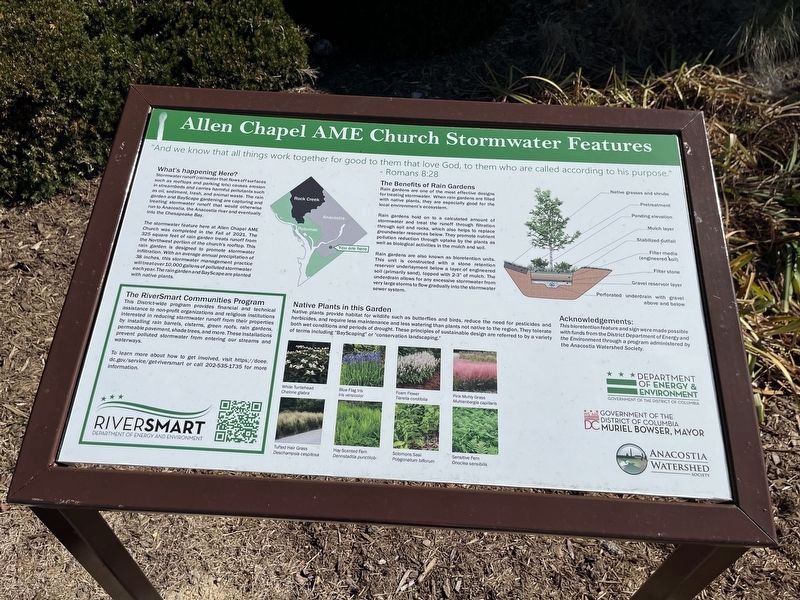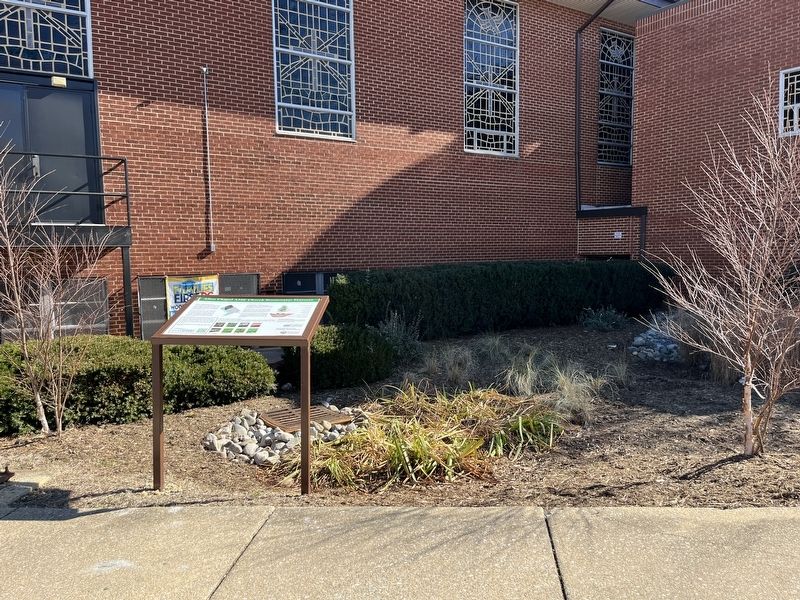Woodland in Southeast Washington in Washington, District of Columbia — The American Northeast (Mid-Atlantic)
Allen Chapel AME Church Stormwater Features

Photographed By Devry Becker Jones (CC0), February 4, 2024
1. Allen Chapel AME Church Stormwater Features Marker
"And we know that all things work together for good to them that love God, to them who are called according to his purpose."
- Romans 8:28
What's happening Here?
Stormwater runoff (rainwater that flows off surfaces such as rooftops and parking lots) causes erosion in streambeds and carries harmful pollutants such as oil, sediment, trash and animal waste. The rain garden and BayScape gardening are capturing and treating stormwater runoff that would otherwise run to Rock Creek, the Potomac river and eventually into the Chesapeake Bay.
The stormwater feature here at Allen Chapel AME Church was completed in the Fall of 2021. The 325 square feet of rain garden treats runoff from the Northwest portion of the church's rooftop. This rain garden is designed to promote stormwater infiltration. With an average annual precipitation of 38 inches, stormwater management practice will treat over 10,000 gallons of polluted stormwater each year. The rain garden and BayScape are planted with native plants.
The Benefits of Rain Gardens
Rain gardens are one of the most effective designs for treating stormwater. When rain gardens are filled with native plants, they are especially good for the local environment's ecosystem.
Rain gardens hold on to a calculated amount of stormwater and treat the runoff through filtration through soil and rocks, which also helped to replace groundwater resources below. They promote nutrients pollution reduction through uptake by the plants as well as biological activities in the mulch and soil.
Rain gardens are also known as bioretention units. This unit is constructed with a stone retention reservoir underlayment below a layer of engineered soil (primarily sand), topped with 2-3" of mulch. The underdrain allows for any excessive stormwater from very large storms to flow gradually onto the adjacent land.
Native Plants in this Garden
Native plants provide habitat for wildlife such as butterflies and birds, reduce the need for pesticides & herbicides, and require less maintenance and less watering than plants not native to the region. They tolerate both wet conditions and periods of drought. These principles of sustainable design are referred to by a variety of terms including "BayScaping" or "conservation landscaping."
White Turtlehead Chelone glabra • Blue Flag Iris Iris versicolor • Foam Flower Tiarella cordifolia • Pink Muhly Grass Muhlenbergia capillaris • Tufted Hair Grass Deschampsia cespitosa • Hay-Scented Fern Dennstadtia punctilob • Solomons Seal Polygonatum biflorum • Sensitive

Photographed By Devry Becker Jones (CC0), February 4, 2024
2. Allen Chapel AME Church Stormwater Features Marker
Acknowledgements:
This bioretention feature and sign were made possible with funds from the District of Energy and the Environment through a program administered by the Anacostia Watershed Society.
The RiverSmart Communities Program
This District-wide program provides financial and technical assistance to non-profit organizations and religious institutions interested in reducing stormwater runoff from their properties by installing rain barrels, cisterns, green roofs, rain gardens, permeable pavement, shade trees, and more. These installations prevent polluted stormwater from entering our streams and waterways.
To learn more about how to get involved, visit https://doee.dc.gov/service/riversmart or call 202-535-1735 for more information.
Erected by DC Department of Environment, Government of the District of Columbia, Mural Bowser, Mayor; Anacostia Watershed Society; Allen Chapel AME Church Stormwater Features.
Topics and series. This historical marker is listed in these topic lists: Churches & Religion • Environment • Waterways & Vessels. In addition, it is included in the African Methodist Episcopal (AME) Church series list. A significant historical year for this entry is 2021.
Location. 38° 51.422′ N, 76° 58.225′ W. Marker is in Southeast Washington in Washington, District of Columbia. It is in Woodland. Marker can be reached from the intersection of 25th Street Southeast and Alabama Avenue Southeast, on the right when traveling south. The marker can be found in the parking lot behind Allen Chapel AME Church. Touch for map. Marker is at or near this postal address: 2498 Alabama Ave SE, Washington DC 20020, United States of America. Touch for directions.
Other nearby markers. At least 8 other markers are within walking distance of this marker. Battery Ricketts (approx. ¼ mile away); Thurgood Marshall (approx. 0.4 miles away); Escape Allée (1838) (approx. half a mile away); Freedom Grove (1838) (approx. half a mile away); Memorial Grove (1841-1895) (approx. half a mile away); Activist Grove (1833-1845) (approx. 0.6 miles away); Original Federal Boundary Stone, District of Columbia, Southeast 4 (approx. 0.6 miles away in Maryland); Fort Stanton (approx. 0.7 miles away). Touch for a list and map of all markers in Southeast Washington.
Additional commentary.
1. About the marker
This sign serves as a historical marker because it demonstrates how this community has made a choice in addressing concerns of environmental stewardship. It shares at length how, why and when it worked on this project.
— Submitted February 4, 2024, by Devry Becker Jones of Washington, District of Columbia.
Credits. This page was last revised on March 3, 2024. It was originally submitted on February 4, 2024, by Devry Becker Jones of Washington, District of Columbia. This page has been viewed 45 times since then. Photos: 1, 2. submitted on February 4, 2024, by Devry Becker Jones of Washington, District of Columbia.